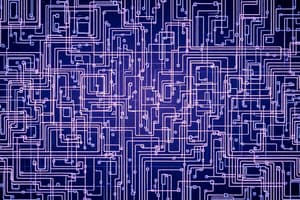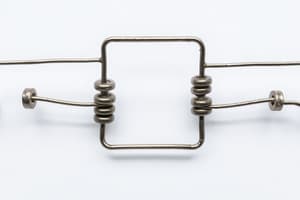Podcast
Questions and Answers
The instantaneous voltage across resistor R is eR = E – ______
The instantaneous voltage across resistor R is eR = E – ______
ec
The instantaneous current passing through R and C is eR iC = R E - ______
The instantaneous current passing through R and C is eR iC = R E - ______
eC
If the charge on the capacitor C is zero at the instant that the switch is closed, then at t = 0, the current passing through R and C is E - eC iC = R ______
If the charge on the capacitor C is zero at the instant that the switch is closed, then at t = 0, the current passing through R and C is E - eC iC = R ______
10 v
This current causes the capacitor C to charge with the polarity illustrated, so that at time t1, the capacitor voltage eC could be ______ volts
This current causes the capacitor C to charge with the polarity illustrated, so that at time t1, the capacitor voltage eC could be ______ volts
This alters eR eR = E – ec = 10 v – 3 v = ______ v
This alters eR eR = E – ec = 10 v – 3 v = ______ v
Because C has accumulated some charge, eC is increased and the voltage across R is reduced; thus the charging current through R is also ______
Because C has accumulated some charge, eC is increased and the voltage across R is reduced; thus the charging current through R is also ______
The product RC is the time constant of the RC circuit. It is the time when the capacitor is charged to 63.2% E, regardless of the value of E, R, and C. At time 5 RC, the capacitor is charged to 99.3% E, regardless of the value of E, R, and C. For practical purposes, it is assumed that the capacitor is fully charged or discharged at t = ____ RC.
The product RC is the time constant of the RC circuit. It is the time when the capacitor is charged to 63.2% E, regardless of the value of E, R, and C. At time 5 RC, the capacitor is charged to 99.3% E, regardless of the value of E, R, and C. For practical purposes, it is assumed that the capacitor is fully charged or discharged at t = ____ RC.
The exponential constant in the RC circuit operation equation is represented by the symbol ______
The exponential constant in the RC circuit operation equation is represented by the symbol ______
When the capacitor is discharged through a resistor without a supply voltage, the capacitor voltage at any time during discharge can be computed using the equation ec = E - (E - Eo)e^(-t/RC), where ec represents the ______
When the capacitor is discharged through a resistor without a supply voltage, the capacitor voltage at any time during discharge can be computed using the equation ec = E - (E - Eo)e^(-t/RC), where ec represents the ______
At t = RC, the current flowing through R and C is _____ % I. Where I is the initial charging current which is equal to E / R.
At t = RC, the current flowing through R and C is _____ % I. Where I is the initial charging current which is equal to E / R.
In an RC circuit, if the capacitor initially has a voltage of -3 volts and is charged from a 6V source through a 10kohm resistor, the capacitor voltage after 8 ms will be ______ volts
In an RC circuit, if the capacitor initially has a voltage of -3 volts and is charged from a 6V source through a 10kohm resistor, the capacitor voltage after 8 ms will be ______ volts
When a capacitor is charged from a DC voltage source through a resistor, the instantaneous level of the capacitor voltage may be calculated at any given time. There is a definite relationship between the time constant of the RC network and the time required for the capacitor to charge to approximately _____ % and 99% of the input voltage.
When a capacitor is charged from a DC voltage source through a resistor, the instantaneous level of the capacitor voltage may be calculated at any given time. There is a definite relationship between the time constant of the RC network and the time required for the capacitor to charge to approximately _____ % and 99% of the input voltage.
Regardless of the values of E, R, and C, the capacitor reaches 63.2% of the charging voltage when the time is equal to ______
Regardless of the values of E, R, and C, the capacitor reaches 63.2% of the charging voltage when the time is equal to ______
During the time that input voltage is positive, C is charged towards the peak voltage of the input signal. The output voltage across R is equal to the input V1 voltage minus the voltage across the _____.
During the time that input voltage is positive, C is charged towards the peak voltage of the input signal. The output voltage across R is equal to the input V1 voltage minus the voltage across the _____.
The initial charge on the capacitor in an RC circuit is denoted by the symbol ______
The initial charge on the capacitor in an RC circuit is denoted by the symbol ______
When the input signal becomes 0 V, the capacitor discharges through R, during which the current is in the reverse direction, causing a negative going pulse across _____.
When the input signal becomes 0 V, the capacitor discharges through R, during which the current is in the reverse direction, causing a negative going pulse across _____.
RC Time Constant represents the time when the capacitor is charged to _____% of the input voltage, regardless of the specific values of E, R, and C.
RC Time Constant represents the time when the capacitor is charged to _____% of the input voltage, regardless of the specific values of E, R, and C.
The time constant in an RC circuit is given by the product of the resistance R and the capacitance C, represented as ______
The time constant in an RC circuit is given by the product of the resistance R and the capacitance C, represented as ______
Flashcards are hidden until you start studying




